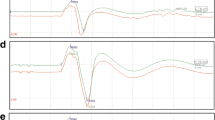Summary
Background. Clinical and experimental data on cerebral blood flow (CBF) changes during spinal cord stimulation (SCS) were published since 1986. The aims of the present work are: 1. To find an experimental model of reliable, simple and in vivo monitoring of “early” basilar artery spasm after subarachnoid haemorrhage (SAH) and 2. To investigate the effects of cervical spinal cord stimulation (CSCS) on it. Vasospasm due to SAH is both “acute” and “recurrent”. Early spasm occurs within minutes of the SAH, its duration is approximately 1 hour. The need of different morphological and haemodynamic methods to evaluate experimental early spasm is reported. To overcome intracranial surgical manipulations and biological effects of contrast and fixation media we designed a model that allows “ in vivo” functional monitoring of basilar blood flow far away from the spasm without direct surgical and chemical interference. Subsequently we investigated the effects of CSCS on the new model of “functional monitoring” of the “early” cerebral vasospasm.
Method. 29 adult Burgundy rabbits were studied. Group 1: under homeostatic monitoring, “on-line” carotid blood flow (carotid BF) changes produced by SAH in cisterna magna of 12 (plus 5 sham treated) animals were studied from the common carotid artery after external carotid artery occlusion before, during SAH and up to the end of the experiments. All the animals underwent digital subtraction cerebral panangiography (CPA) after SAH obtaining a significant increase of carotid BF only when basilar vasospasm was shown by CPA. Carotid BF increase during basilar vasospasm was defined “functional monitoring” of early spasm. Group 2: Twelve animals wearing a cervical epidural electrode underwent carotid BF “functional monitoring” of early basilar spasm before and during CSCS.
Findings. Carotid BF changes during CSCS occurred in 10 animals. No carotid BF changes (i.e. no basilar vasospasm) occurred after SAH up to the end of the experiments in all the stimulated animals.
Interpretation. CSCS is able to prevent “early spasm” due to SAH in all the animals studied with the new model of “functional monitoring” described, independently from the occurrence and the sign for stimulation-induced carotid BF variations. The role and the limits of reversible functional sympathectomy in mediating the effect of CSCS on early vasospam are discussed.
Similar content being viewed by others
Author information
Authors and Affiliations
Rights and permissions
About this article
Cite this article
Visocchi, M., Argiolas, L., Meglio, M. et al. Spinal Cord Stimulation and Early Experimental Cerebral Spasm: The “Functional Monitoring” and the “Preventing Effect”. Acta Neurochir (Wien) 143, 177–185 (2001). https://doi.org/10.1007/s007010170126
Issue Date:
DOI: https://doi.org/10.1007/s007010170126




